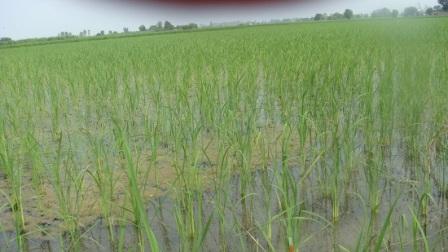In partnership with the Columbia Water Center, researchers from Punjab Agricultural University have initiated a multi-year project to implement and field-test diverse water-saving technologies, practices and policies aimed at reducing agricultural water use in the state of Punjab, particularly among rice farmers. In last year’s trial, the most successful project involved the installation of inexpensive tensiometers in the fields of over 500 farmers, yielding water savings of 30-35 percent.
Concurrently with the tensiometer trials, the team also recruited a smaller number of farmers to adopt a different way of cultivating rice altogether: Direct seeding of rice.
In traditional rice cultivation, rice is sprouted in a nursery; sprouted seedlings are then transplanted into standing water. With direct seeding, rice seed is sown and sprouted directly into the field, eliminating the laborious process of planting seedlings by hand and greatly reducing the crop’s water requirements.
 Conventional rice production requires standing water
Conventional rice production requires standing water
For the CWC/PAU field project, professors Kamal Vatta and Rajinder Sidhu recruited 87 farmers to use the direct seeding approach. Initial results were mixed. Because it was an unusually wet year (30 percent higher than average) with early rainfall, seeds in 35 fields did not germinate as expected; those farmers abandoned the experiment, plowed back their fields and planted rice the traditional way.
However, results from the 52 farms that remained were promising; each farm saving substantial amounts of water with no negative impact on yield. According to Professor Sidhu, water savings are at least as great as those achieved by the use of the tensiometer.
 Field of direct-seeded rice
Field of direct-seeded rice
Direct seeding of rice is not a new idea; a number of farmers throughout Asia have cultivated the crop this way for decades. Perhaps most famously, beginning in the 1950s Masanobu Fukuoka, the Japanese farmer-philosopher and author of The One Straw Revolution, flouted both traditional Japanese rice cultivation and industrial production models by seeding rice directly and keeping fields dry for most of the season. Fukuoka’s method involved an elaborate system of groundcovers and crop rotation to minimize competition from weeds.
As usually practiced, however, weed control is a serious challenge for the direct seeding approach. Weeds are one of the main reasons rice is traditionally sprouted in nurseries and transplanted; standing water prevents germination of competing plants.
According to Professor Sidhu, researchers at the Punjab Agricultural University experimented with the direct seeding approach years ago but abandoned it when results showed that “the infestation of weeds is so high that it significantly reduces yield; therefore it was dropped from the research agenda.”
At the time, he says, University research focused almost exclusively on “maximizing productivity in relation to water use, rather than optimizing productivity in relation to water use.” It wasn’t until the 1990s, when awareness of a looming water crisis began to grow, that PAU researchers began to look more seriously at the water issue.
In the end though, it was field experience from a number of progressive farmers in Punjab who had taken up direct seeding on their own that spurred the University to begin a new round of experiments. The farmers claimed that they were successfully using direct seeding to grow rice, with no negative impact on yield. Around the same time, says Sidhu, a new generation of weedicides appeared on the market, allowing for a very effective suppression of weeds without standing water.
Positive results from the PAU’s own research led the University to issue a temporary recommendation to farmers for direct seeding, pending further field tests.
What is the downside? According to Sidhu, compared to using tensiometers, farmers were less enthusiastic about direct seeding, probably because it requires a completely different method of cultivation over conventional practices, and germination failure can also be an issue.
On the other hand, direct seeding of rice—especially if using weedicdes—is substantially more labor-efficient than conventional rice planting. Given the emerging issue of serious labor-shortages in the state of Punjab, techniques like direct-seeding could become much more popular fast.
 Unlike flooded rice fields direct-seeded rice can be grown amongst tree crops
Unlike flooded rice fields direct-seeded rice can be grown amongst tree crops
And what about concern over increased use of weedicides? Sidhu says that we don’t know if there will be negative consequences from the weedicides used on direct-seeded fields. But given the emerging concern in Punjab and elsewhere over rising rates of cancer and ecological damage, it would seem to be an issue to take seriously.
Retired professor SS Johl, a long time luminary in the world of Punjab agricultural research, believes that it is possible to use direct-seeded cultivation without application of weedicides—if one has the labor. He points out that with direct seeding of rice, the labor saved upfront on transplanting can be applied later to weeding. “If you have the labor,” he says, “you should not apply weedicide.”
Click here to read the entire article
/articles/direct-seeding-rice-simple-solution-india-s-water-crisis